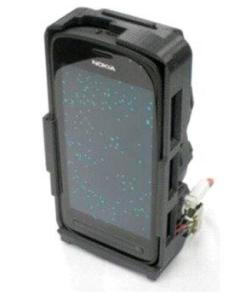Scientists are reporting an advance in smartphone-based imaging that could help physicians in far-flung and resource-limited locations monitor how well treatments for infections are working by detecting, for the first time, individual viruses. Their study on the light-weight device, which converts the phone into a powerful mini-microscope, appears in the journal ACS Nano.
 An advance in smartphone-based imaging could help physicians in far-flung and resource-limited locations monitor how well treatments for infections are working. Credit: American Chemical Society
An advance in smartphone-based imaging could help physicians in far-flung and resource-limited locations monitor how well treatments for infections are working. Credit: American Chemical Society
Aydogan Ozcan and colleagues note that conventional imaging techniques for detecting disease-causing bacteria and viruses rely on expensive microscopes with multiple lenses and other bulky optical components. In places with limited resources, doctors have few options for determining how well a treatment is working. To address the need for more portable and less expensive medical equipment, researchers, including Ozcan’s group at the University of California, Los Angeles, recently have developed various compact microscopes that can be fitted onto smartphones to detect microbes or to check patients’ eyesight. The team set out to build on these advances and produce a more refined imaging device that works on the nanoscale to count the number of sub-micron bacteria or viruses in a sample.
The result is a portable imaging system that harnesses the digital power of today’s smartphones to detect individual viruses and determine viral load — the severity of infection — which can indicate the effectiveness of a treatment. It only weighs six-and-a-half ounces, or little more than a baseball. Using their new smartphone microscope, the scientists detected individual, fluorescently labeled human cytomegalovirus, a member of the herpes virus family that can be life-threatening in patients with low immunity. It’s also one of the leading causes of virus-associated birth defects. The scientists conclude that the microscope “holds significant promise for various point-of-care applications such as viral load measurements or other biomedical tests conducted in remote or resource-limited environments.”
The authors acknowledge funding from Nokia University Collaboration Funding, the Presidential Early Career Award for Scientists and Engineers, the U.S. Army Research Office, the National Science Foundation, the U.S. Office of Naval Research and the National Institutes of Health.